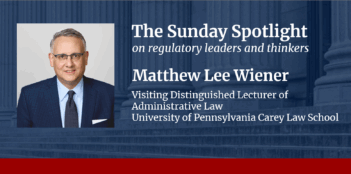
Scholar proposes a rule design framework for defining the regulator-regulatee relationship.
If regulators do not have a way of distinguishing between different types of rules, how can they design regulations that most effectively address the problems they intend to?
In a recent paper, Cary Coglianese, a professor at the University of Pennsylvania Carey Law School, proposes a uniform approach for thinking about the design of rules that ultimately define the relationship between regulators and regulated entities.
Coglianese argues that the relationship between regulators and those they regulate is fundamental to “the regulatory endeavor,” and that the design of rules must consider this relationship. Coglianese advances a framework aimed at providing clarity to both regulators and “regulatees” about rule design, and thus improving the effectiveness of regulation broadly.
He argues that regulation is fundamentally a relational enterprise. This is because regulation is about shaping behavior. Regulators seek to influence the behavior of those they regulate, and regulatees often seek to shape the behavior of regulators. The effectiveness of a rule, therefore, often depends on whether it is designed with the nature of this relationship in mind.
Coglianese explains how the design of rules can vary. They can demand much of regulated firms, or they can be lax. Rules can also provide regulated firms with greater or less flexibility and discretion. A regulator needs to make choices about these and other characteristics of a regulation based on the problem the regulator seeks to solve, as well as the nature of the regulatee. By thinking about those affected by a regulation, regulators are acting in a relational capacity.
A substantial body of research about rule design exists, but Coglianese explains that regulators have “long lacked a clear and common taxonomy of rule design.” A more uniform framework, Coglianese argues, could help regulators better understand and design rules in light of their relationship with regulated entities.
The uniform framework Coglianese proposes has two dimensions: a means-end dimension, and a micro-macro one. He notes that the labels for these dimensions emerged from a National Academy of Sciences, Engineering, and Medicine study that drew on his earlier work.
The means-end dimension describes whether a rule focuses on the actions of regulated entities—means—or on outcomes to be achieved or avoided—ends.
The macro-micro dimension describes whether a rule is focused on a contributor to a problem—a micro rule—or on the problem itself—a macro rule.
Taken together, these two dimensions result in four distinct designs: micro-means, micro-ends, macro-means, and macro-ends.
Coglianese explains that this fourfold set of rule types can help regulators better define the regulator-regulatee relationship.
Micro-means rules, or “prescriptive” regulations, are appropriate when a regulatory problem or risk is shared and is relatively stable across regulated entities, Coglianese explains. When this is the case, a regulator can specify the exact behaviors or actions that regulatees must take, because a one-size-fits-all strategy may account for any regulated entity.
Micro-ends rules, or “performance-based regulations,” give regulated entities flexibility in their operations because they only require regulated entities to achieve or avoid specific outputs along the path leading toward a hazard. An example of this type of rule is a limit on air pollution emissions from an industrial facility, because the limit is only a mandate on the “end” and imposes no requirements as to how the regulatee will achieve this goal. The flexibility that micro-ends rules provide can be a benefit, but Coglianese cautions that regulators who pursue this type of rule should be able to monitor compliance. Otherwise, regulated firms may meet an output requirement on paper but because the “means” of doing so are not monitored, these firms may find ways to evade the rule’s overall spirit.
Macro-means rules, or “management-based regulations,” direct firms’ attention to the ultimate problem and steer managers in the direction of improved risk control. This type of regulation creates requirements for firms’ internal planning and management practices. An example of this type of rule is one that requires a food processor to assess food safety risks in their operations and develop plans to reduce them.
Macro-ends rules, or “general duty clauses” that impose liability for harm, represent the final rule design in Coglianese’s framework. These rules create an obligation for regulated firms to avoid accidents or catastrophes, and to pay a penalty if these hazards occur. These rules serve a deterrent purpose, providing incentives for regulated entities to take preventive action to avoid penalties and liability.
These four rule designs make up the “regulator’s toolkit.” Coglianese argues that a task that regulators must take seriously is choosing the right regulatory tool, based on which tool will most effectively address the problem at hand. Choosing the right rule design, Coglianese argues, is essential if regulators want to establish and maintain the type of relationships with regulatees that solve policy problems.



